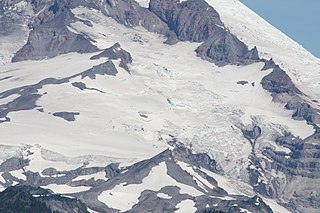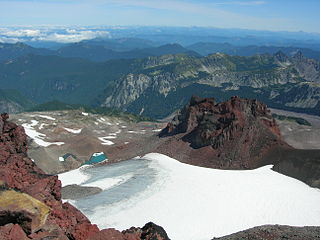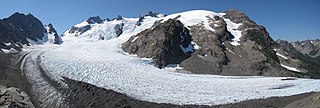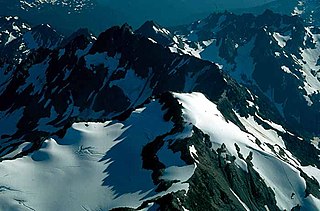
Mount Anderson is a 7,330-foot-high (2,234 m) peak in the Olympic Mountains of the Pacific Northwest. Rising in the center of Olympic National Park in Washington state, it is the second highest peak on the Anderson Massif, after West Peak. Anderson Glacier used to be located in a cirque on the mountain's southern flank while Eel Glacier is in another cirque, northwest of the summit. Hanging Glacier is on the east side of a ridge which extends north from the peak.

Emmons Glacier is on the northeast flank of Mount Rainier, in Washington. At 4.3 sq mi (11 km2), it has the largest surface area of any glacier in the contiguous United States. The glacier was named after the geologist Samuel Franklin Emmons after his involvement in a survey of Mount Rainier in 1870.

The Cowlitz Glacier is on the southeast flank of Mount Rainier in the U.S. state of Washington. The body of ice covers 1.3 square miles (3.4 km2) and has a volume of 6 billion ft3. The glacier starts at an elevation of 10,700 feet (3,300 m) and flows southeast. An adjacent glacier, the Paradise Glacier, is connected to this glacier on its southwest margin. As it flows down the slopes of Mount Rainier it nearly meets up with the Ingraham Glacier and during the Little Ice Age, which ended around the year 1850, the two glaciers shared a common terminus. Meltwater from the glacier drains into the Cowlitz River.

Flett Glacier refers to two glaciers on the northwestern flank of Mount Rainier in the U.S. state of Washington. The glaciers lie on a subsidiary peak of Rainier, the 8,364 feet (2,549 m) Observation Rock. There are two sections of glacial ice, an eastern lobe at about 7,600 ft (2,300 m) to 7,300 ft (2,200 m) in elevation, a smaller western lobe at about 7,200 ft (2,200 m) in elevation. Meltwater from the glacier flows into the Puyallup River.
Rusk Glacier is located on the eastern face of Mount Adams in the U.S. state of Washington. Starting at an elevation of over 10,200 ft (3,100 m) at just below The Castle, the glacier flows eastward down slope. A significant portion of the glacier is covered by rock debris and in the middle of the glacier, at about 9,200 ft (2,800 m), there is a small ice-free island of rock. The glacier terminates at about 7,500 ft (2,300 m) at its rock-covered moraine. The glacier has decreased in surface area by 23 percent between 1904 and 2006.

Blue Glacier is a large glacier located to the north of Mount Olympus in the Olympic Mountains of Washington. The glacier covers an area of 1.7 sq mi (4.4 km2) and contains 580,000,000 cu ft (16,000,000 m3) of ice and snow in spite of its low terminus elevation. The glacier length has decreased from about 3.4 mi (5.5 km) in 1800 to 2.7 mi (4.3 km) in the year 2000. Just in the period from 1995 and 2006, Blue Glacier retreated 325 ft (99 m). Blue Glacier is also thinning as it retreats and between 1987 and 2009 the glacier lost 178 ft (54 m) of its depth near its terminus and between 32 and 48 ft in the uppermost sections of the glacier known as the accumulation zone.

White Glacier is located on the north slopes of Mount Tom in the Olympic Mountains and Olympic National Park in the U.S. state of Washington. The main portion of the glacier heads at around 7,000 and 6,400 feet in a cirque just under the summit rocks, while the westernmost section of White Glacier is partially separated from the rest of the glacier by several small ridges of rock and flows straight north. The principle portion of the glacier flows north as well, with a glacier toe descending to around 4,800 feet (1,500 m) where the toe turns northeast to its terminus at 4,400 feet (1,300 m). Steep ridges of rock separate an eastern portion of the White Glacier from the Blue Glacier cirque on adjacent Mount Olympus, to the east.

Hubert Glacier is located on the south side of Mount Olympus in the Olympic Mountains and Olympic National Park. Due to its southern orientation, the glacier is smaller than those on the north side of Mount Olympus, such as Blue Glacier.

Anderson Glacier was a glacier located in a cirque south of Mount Anderson in the Olympic Mountains and Olympic National Park. The southward-facing glacier starts on the steep headwalls of the cirque at about 6,200 feet (1,900 m) to 6,000 ft (1,800 m). It flows down to about 5,240 ft (1,600 m) before terminating. Meltwater from the glacier enters a lake at about 4,949 ft (1,508 m) before tumbling down a steep cliff. Between 1927 and 2009, Anderson Glacier lost more than 90 percent of its surface area. By 2011, the glacier was gone. The lack of glacial meltwater from the Anderson Glacier has caused the Quinault River to reach new recorded lows.
Hanging Glacier is a located northeast of Mount Anderson in the Olympic Mountains and Olympic National Park, U.S. state of Washington. The glacier starts north of a saddle between Mount Anderson and East Peak at about 5,700 feet (1,700 m). Like all the glaciers in Olympic National Park, Hanging Glacier is in a state of retreat.
Ice River Glacier is located 2.4 miles (3.9 km) northeast of Mount Olympus in the Olympic Mountains of Olympic National Park in the U.S. state of Washington. Starting at an elevation of 6,400 feet (2,000 m) on the northern slope of a subpeak of Mount Olympus known as Mercury, the glacier flows northwest as it descends. The glacier reaches as low as 5,200 ft (1,600 m) before terminating. Though the glacier lies adjacent to the much larger Blue Glacier, an arête separates the two glaciers.

Queets Glacier is located in the Olympic Mountains in Olympic National Park in the U.S. state of Washington. The glacier lies on the northwest side of Mount Queets at an elevation of about 5,564 feet (1,696 m), the glacier descends northwest, bounded by two arêtes on either side. The ice reaches as low as 5,000 ft (1,500 m) before terminating and giving rise to the headwaters of the Queets River.
Jeffers Glacier is southeast of Mount Olympus in the Olympic Mountains in Olympic National Park, Washington, US. The glacier is relatively small compared to the nearby Hoh Glacier. Beginning at the foot of a very steep headwall at about 5,800 feet (1,800 m), the glacier descends northeast to about 4,900 ft (1,500 m) before terminating. Meltwater from the terminus flows to the Queets River.
Carrie Glacier is located on Mount Carrie and Mount Fairchild in the Olympic Mountains of Olympic National Park. Starting at an elevation of about 6,800 feet (2,100 m), the glacier descends northward, but the ice soon reaches a cliff. Part of the Carrie Glacier plunges over the steep rockwall, contributing ice to an adjacent glacier, while the other section flows north-northeast, avoiding the precipitous drop. This segment of ice is confined by an arête to the west and Mount Fairchild to the east in a chute. The glacier reaches as low as 5,000 ft (1,500 m) before terminating. There are several other patches of snow and glaciers located nearby, such as the Fairchild Glacier.

Fairchild Glacier is located in the U.S. state of Washington on Mount Fairchild and Mount Carrie in the Olympic Mountains of Olympic National Park. Beginning at an elevation of about 6,600 feet (2,000 m) along the Bailey Ridge, the glacier descends northeast and is .30 mi (0.48 km) northeast of Carrie Glacier. Like all the glaciers in Olympic National Park, Fairchild Glacier has been in a general retreat for over 100 years. The glacier is named for William R. Fairchild, who was a pilot that assisted scientific researchers in the region.
White Salmon Glacier is located on Mount Adams in the U.S. state of Washington. The glacier starts southwest of the summit crater at an elevation of 11,600 ft (3,500 m). Ice flows southwest downhill until the glacier's terminus at about 9,600 ft (2,900 m) elevation. The glacier also contributes ice to the much larger Avalanche Glacier at an elevation of 10,200 ft (3,100 m). White Salmon Glacier has decreased in surface area by 86 percent between 1904 and 2006.

Mount Rainier, also known as Tahoma, is a large active stratovolcano in the Cascade Range of the Pacific Northwest in the United States. The mountain is located in Mount Rainier National Park about 59 miles (95 km) south-southeast of Seattle. With a summit elevation of 14,417 ft (4,394 m), it is the highest mountain in the U.S. state of Washington and the Cascade Range, the most topographically prominent mountain in the contiguous United States, and the tallest in the Cascade Volcanic Arc.

Humes Glacier is located in the Olympic Mountains in Olympic National Park, approximately 2.25 miles (3.62 km) southeast of the summit of Mount Olympus. The glacier starts at nearly 6,000 ft (1,800 m) and descends downslope 1.25 mi (2.01 km), terminating at 4,800 ft (1,500 m) above sea level.

Banded Glacier is located on the north slopes of Mount Logan, North Cascades National Park in the U.S. state of Washington. The glacier is approximately .60 mi (0.97 km) long and flows down from just east of the summit of Mount Logan to an elevation of approximately 7,200 ft (2,200 m) where it terminates at a proglacial lake.

Fremont Glacier is located on the southeast slopes of Mount Logan, North Cascades National Park in the U.S. state of Washington. The glacier is approximately .50 mi (0.80 km) long but nearly 1 mi (1.6 km) wide and flows down from just southeast of the summit of Mount Logan to an elevation of approximately 7,200 ft (2,200 m).















